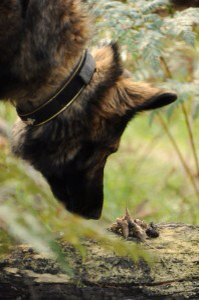
Scat.
If shown sixteen different pictures of animal scat, most of us wouldn’t be able to tell a river otter’s scat from a bobcat’s, but a dog can tell just by smell. This marvelous ability helps eco-scientists working with a “scat tracker” to help threatened and endangered animals.
“Scat trackers” are dogs that can locate fresh scat from multiple species simultaneously across large, remote areas repeatedly over time. Sampling with scat trackers tends to be less biased than traditional wildlife detection methods (remote cameras, radio-collaring, hair snags, etc). Ideal scat trackers are intensely focused dogs with an insatiable urge to play. Many of them are too challenging to be family pets because of their obsessive, high-energy personalities. The dogs locate samples based on olfactory cues subject to the age of the sample, wind direction, degree of moisture, sun exposure, insects, and location (e.g., under vegetation or exposed).
These dogs are mixed breed and purebred dogs, some from shelters, some from service dog programs that weren’t a good fit for the dog, and some from breeders who recognize traits useful for conservation work. Many are Labrador Retrievers and German Shepherd Dogs whose longer legs are strong and allow them to search for scat over varied terrain up to five miles a day. A group like Working Dogs for Conservation relies on a wide network of colleagues, friends, and rescuers to help them identify, test, and relocate dogs. One such dog is “Sara,” a Labrador Retriever described as “stubborn, headstrong and very much like a state fair tractor pull.” Sara’s travels have taken her to North Luangwa National Park in Zambia. Another dog, Seamus, a Border Collie, helps conservationists find evidence of the endangered San Joaquin kit fox in California. You can meet more of WDC’s dogs here.
Scat is so important because it helps scientists study the DNA and hormones found in an animal’s body waste. The droppings also reveal details about an animal’s nutritional health, reproductive status, and even how well its immune system is working. In many cases, scat even contains traces of toxins the animal may have been exposed to in its environment.
Image of scat detection dog found on Pinterest and happily credited upon receipt of information
